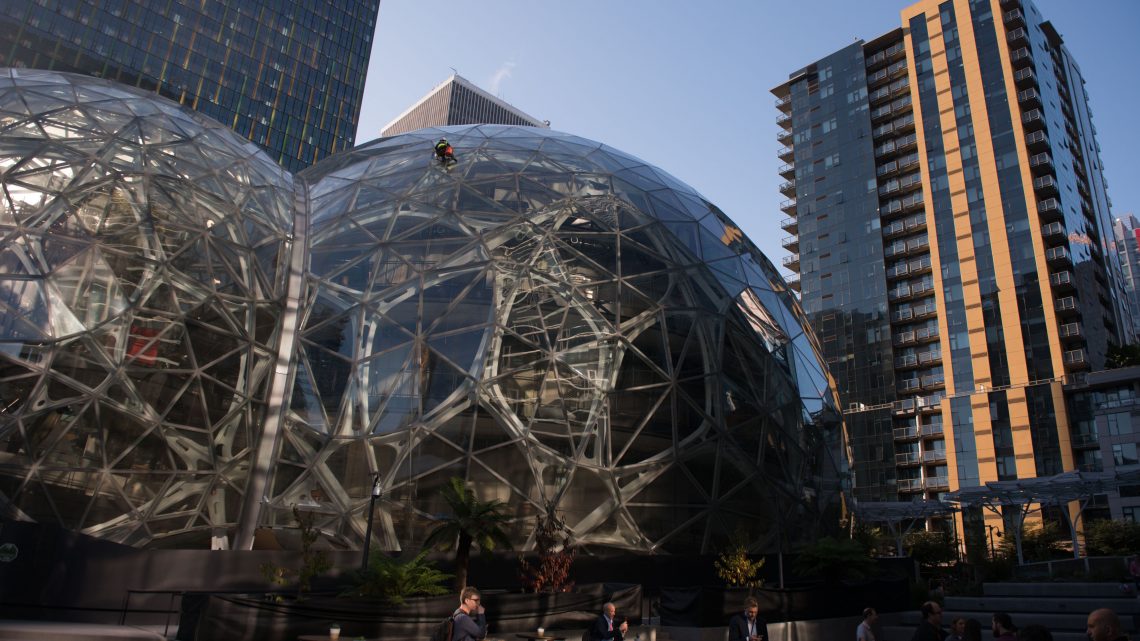
What Will Amazon’s HQ2 Mean for Transit in Queens?
November 15, 2018In early 2019, the L train in New York City will shut down for 15 months to repair damage caused during Hurricane Sandy. Leading up to the closure, VICE will be providing relevant updates and policy proposals, as well as profiles of community members and businesses along the affected route in a series we're calling Tunnel Vision. Read more about the project here.
On Tunnel Vision, VICE has dedicated a substantial amount of space to western Queens.
The underlying theme has been the fragility of its transit: the subway system, with its lackluster performance, can barely keep up with demand right now, let alone when thousands of new high-rise units come online. Long Island City, the neighborhood that’s contributing the most to this growth, is currently seeing the highest rate of construction in America. And if that’s not problematic, Court Square, its central crammed hub, will have to somehow make space for hordes of rerouted passengers when the L train goes offline in April 2019, as VICE reported in March.
As a western Queens resident myself, I was worried. Each morning, when my subway pulls up to Court Square, it’s already packed with populations from eastern and central parts of the borough; Long Island City, for context, is the last neighborhood before entering Manhattan, meaning by that point, the train has picked up a lot of passengers. And Court Square’s platform seems to get busier with each passing week. Thousands of new residents and the impending L train shutdown seemed practically unfathomable for this infrastructure.
This was my feeling way before the news was made official on Tuesday that Amazon had chosen Long Island City as its co-location for HQ2, promising to add at least 25,000 jobs (and commutes) to this very spot, not counting the thousands of other jobs (and commutes) that will spring from one of the world’s largest companies being here. It’s unprecedented for New York City, in terms of sheer numbers. And now the sentiment surrounding transit in western Queens—shared by a growing Greek chorus of residents and politicians—has gone from unfathomable to impossible.
Let’s put aside the other outstanding questions about HQ2—namely: What does this mean for the residents who live here? How will this benefit the country’s largest public housing project next door? And did Amazon really need at least $1.7 billion in tax breaks and a helipad?—and focus specifically on transit. Not only because that’s what Tunnel Vision is all about, but also because transit was a crucial reason as to why Amazon chose New York City for this. When Amazon representatives visited New York, officials even reportedly rode ferries and CitiBikes with them as selling points.
“Long Island City has some of the best transit access in New York City,” writes the company in the official announcement, “with 8 subway lines, 13 bus lines, commuter rail, a bike-sharing service, and ferries serving the area, and LaGuardia and JFK airports are in close proximity.”
We’ll start first with the eight subway lines. In particular, the two issues facing these subways, as demonstrated, are performance and overcrowding. New York’s subway system has the worst on-time performance rates of any major city metro in the world, meaning that trains are delayed, and often. There is, however, hope that things are turning around; in October, the trains hit a 70 percent on-time rate for the first time in years. But still, getting to a sustainable level of service with the system’s outdated infrastructure and mountain of needs will take years, and billions of dollars.
The 7 train, which crosses right through Amazon’s planned site, is expected to be upgraded to a new signal system by the end of this year, which will increase the number of trains at peak hours, and their reliability. But the rest of the local lines in question—the E, F, M, and R—are still waiting on funding for the upgraded signal system; once procured, that could take years to complete, given how long the 7 and L took. Until the L train comes back online, in late 2020, the G train will face intense capacity issues. (The 7, M, and G will see more trains during the shutdown, but whether that service will stay around post-shutdown, when Amazon actually arrives, is unclear.)
Not surprisingly, Amazon has already promised to invest millions of dollars “in infrastructure improvements and new green spaces.” That’ll happen through a PILOT, or Payment in Lieu of Taxes, where the state will siphon half of what Amazon would normally pay in property taxes specifically to an infrastructure fund. The only issue there is that a portion of money will not be available for 15 years, the state has said, and will go to the city, not the state, which ultimately oversees the subways.
In regards to the subways, a question that my colleague Matt Taylor confronted on Tuesday is worth repeating here: what does it mean when private companies like Amazon are influencing public policy and investment?
Of course, this blurs the line of corporate and public interest, but this is America, and not without precedent. Especially in New York. As VICE has explained, the subway system was built by two private companies, bolstered by governmental contracts, and, later, authority. The only reason why Astoria, where I live, has two seperate train lines—the N/W, and the M/R—is because the owners of the Steinway piano factory, then a titan of industry in the area, wanted more service for their workers. (Their influence also paved the way for the 7 train tunnel.) Those stations helped build the local ecosystem here, so much so that when one of the subway stations closed last year, the small business community took a beating.
Read: How the L Train Shutdown Will Impact the Environment
At a press conference this week with Governor Andrew Cuomo and Mayor Bill de Blasio—who put their tenuous relationship on hold for a day to announce the news together—the two were predictably peppered with questions about the subways. And although vague on details about the infrastructure fund, they basically confirmed that, yes, Amazon’s presence would ultimately lead to more money for mass transit. “I think we have short-term and long-term answers, but will the additional revenue help us with the stressed budget, no doubt,” said Cuomo.
A few weeks before the Amazon announcement, the city announced a major infusion of money into Long Island City’s infrastructure, perhaps foreboding of what was to come. The investments were undoubtedly needed; you’d be hard pressed to find a New Yorker who doesn’t think the growth of the area is far outpacing the street-level infrastructure. Yet most of the proposals in the ‘transportation’ section of the strategy were not new, and those that were—like building a new Long Island Rail Road station at the Amtrak depot in Sunnyside Yards, and funding new subway station upgrades—would take years and billions to complete.
In his comments on Tuesday, de Blasio touted the transit projects that could come to the area. Shuttle buses could buttress ferry service, he said, which the city is looking to expand. A Queens-wide bus route redesign, as part of the city’s larger bus system overhaul, will be completed by 2021 deadline. And also, what about Brooklyn-Queens Connector, or BQX, the light-rail project that would cut right through LIC, yet will cost $4 billion and take 10 years to build? (Its supporters, including the mayor, are hoping HQ2 fast-tracks it.)
“We’ll look at every kind of option, because this is something that community residents have raised. It’s absolutely valid,” said the mayor. “By the way, Amazon or no Amazon, this is something we have to address in the long haul, certainly I’ve heard that from the local representatives many times.”
This, it seems, is the main issue right now: the “long haul.” Amazon’s incremental arrival over the next few years will likely not be met by the transit it needs in time, either because of lengthy construction timelines (the signal system as one example); lack of funding (the subway’s Fast Forward plan still hasn’t been paid for); or tangled politics (the Times is reporting that Amazon demanded that Cuomo and de Blasio get along). And some of the proposals that Amazon prided its decision on, like the ferries and CitiBike, can service a small sliver of New Yorkers, but are not realistic transit options for the mini-economy Amazon is about to spawn.
And finally, the “local representatives” that the mayor mentioned actually have serious concerns about the project, and its impact on transit. Congresswoman-elect Alexandria Ocasio-Cortez, who represents the area just north of Long Island City, made mention of the subways in her tweet lambasting the decision. State Senator Michael Gianaris and City Council Member Jimmy Van Bramer, both of whom represent the district, are at odds with the tax breaks, but tellingly mentioned “our subways are crumbling” as the first issue at hand.
“Too much is at stake to accept this without a fight,” they said in a statement. “We will continue to stand up against what can only be described as a bad deal for New York and for Long Island City.”
Sign up for our newsletter to get the best of VICE delivered to your inbox daily.
Follow John Surico on Twitter.


